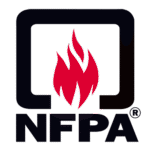NFPA 2112 is the standard for flame-resistant garments used to protect industrial personnel against flash fire. It’s not a test method itself, but rather a performance standard that outlines the minimum design, performance, certification, and verification requirements for these garments.
- NFPA 2112 details a comprehensive set of test methods to evaluate the performance of flame-resistant garments. Among these, four critical tests determine a garment’s pass or fail status:
- Flame Resistance: Ensures the fabric self-extinguishes and doesn’t propagate flames.
- Manikin Testing (ASTM F1930): Evaluates the garment’s overall thermal protective performance in a simulated flash fire scenario.
- Thermal Shrinkage Resistance: Verifies that the fabric doesn’t excessively shrink when exposed to heat, maintaining coverage.
- Heat Resistance: Confirms the garment’s integrity, ensuring no melting, dripping, or ignition at high temperatures.
- Labeling: specifies requirements for garment labeling, materials, and components like zippers and thread.
The remaining tests outlined in NFPA 2112 are report-only. For these, data is collected and recorded, providing valuable information about the fabric’s properties, but the results themselves are not used as direct pass/fail criteria for certification.
Cold Weather Insulation Guidance
NFPA 2112 also includes specific guidance for flame-resistant (FR) cold weather insulation. This means that insulating materials used in FR garments for cold environments must also meet strict flame resistance criteria. They’re put through the ASTM D6413 Vertical Flame Test, and to pass, the fabric must:
- Self-extinguish once the direct flame is removed.
- Not melt or drip.
- Have a char length of less than 4.0 inches.
- Exhibit an afterflame of less than 2.0 seconds.
Non-FR Emblems
NFPA 2112 has also addressed the use of non-flame-resistant (non-FR) emblems on garments, adding specific requirements in Annex A.7.1.2.1. This ensures that while branding or other decorative elements can be used, they don’t compromise the garment’s overall protection. The rules are:
- A maximum of five non-FR emblems can be attached to the exterior of a single garment.
- Each individual emblem cannot exceed an area of 16 square inches.
- The combined total area of all non-FR emblems on a garment is limited to 40 square inches.


